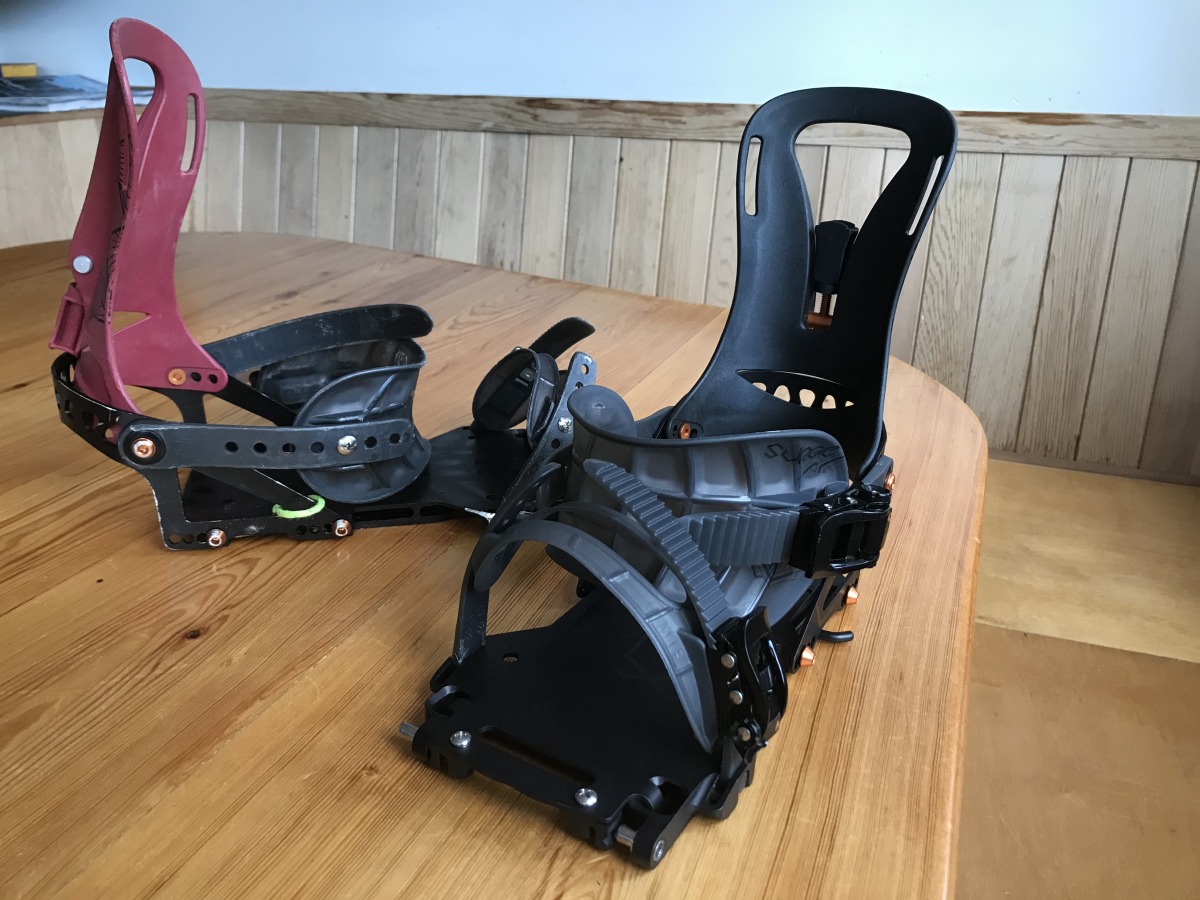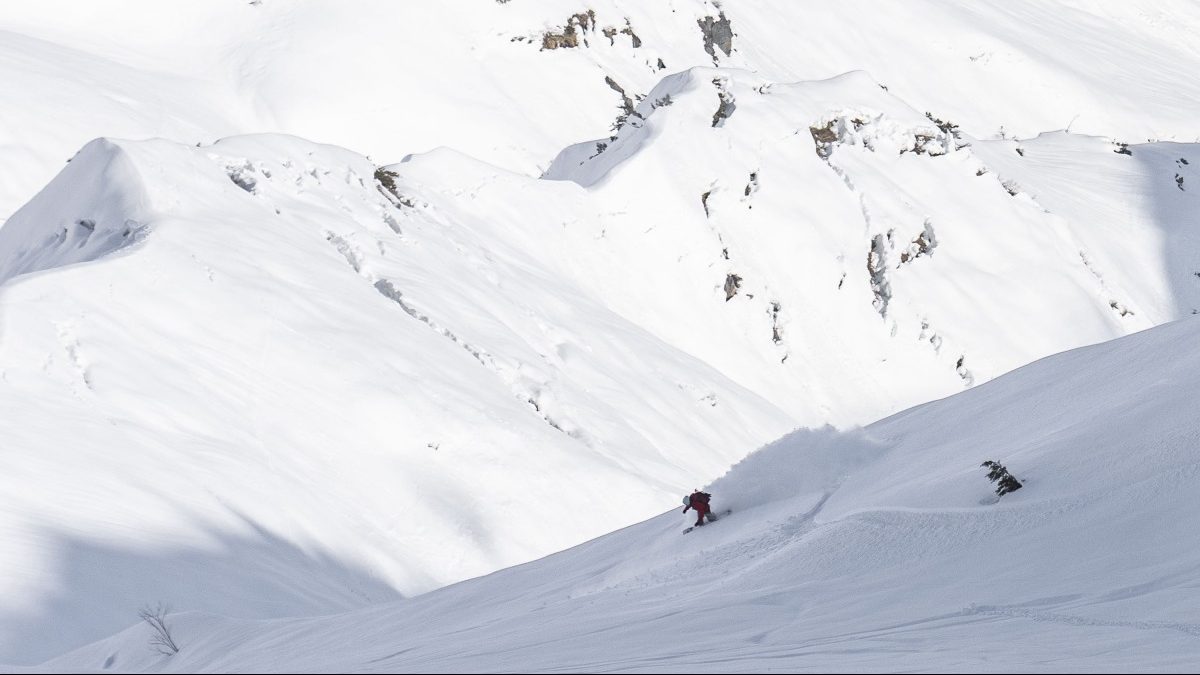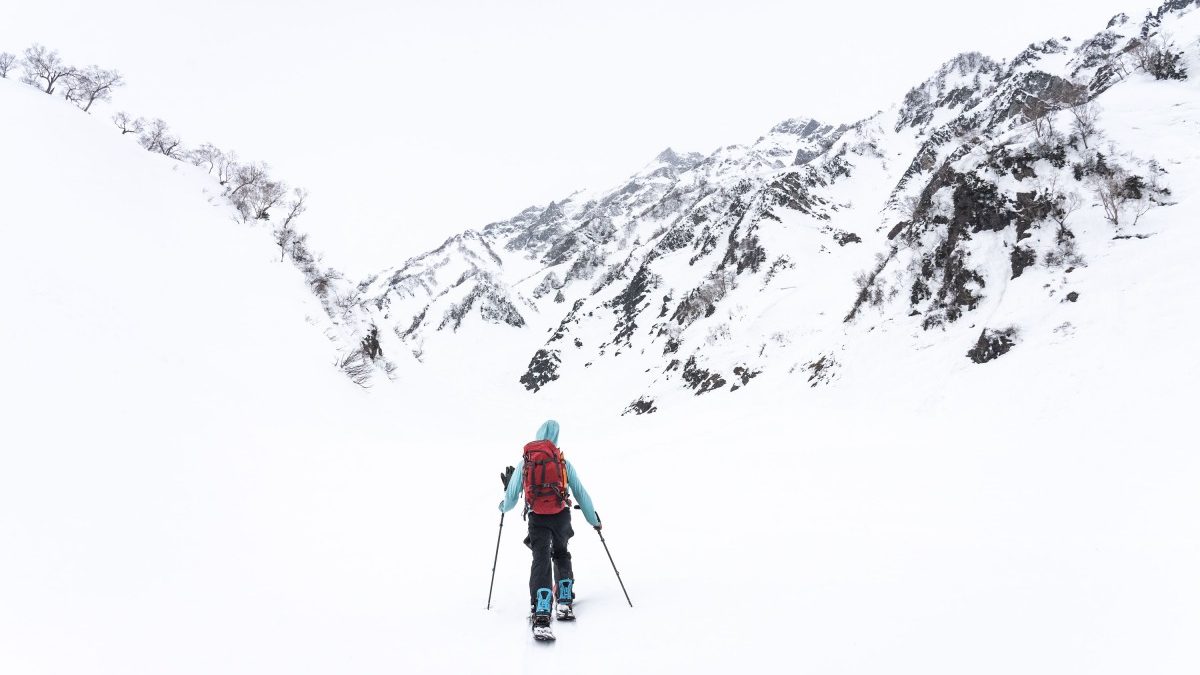
Base Spark Surges galloping up Sarukura Sawa enroute to Shakushi Dake. Japanese Alps Photo: Rolland Miller
My initiatory splitboarding experience was in my first avalanche class. A splitboard was required gear, and I was lent one by a friend. In 2007, I used gear like my heroes from the 90’s, and this splitboard looked the part. It was long for me – 171 – way too stiff, and I used Voile’s plate mounts, with my bindings t-nutted to them. This was the current standard. To say the least, it was heavy, clunky, and collected more snow than my cotton layers did moisture. Luckily I kept track of my pins!
The course was led by a hard core Swiss IFMGA guide. He [and others] frequently lamented about the inefficiencies of splitboarding, evangelizing AT. This personal history has led to one perception I’ve clung to: Be faster, stronger, and more streamlined than everyone who skis. My ego – and snowboarding’s – depended on it. Thankfully, the gear has evolved to help me out.
I’ve chosen the Spark Pro Surge as my go-to binding for all my adventures. I find it exceptionally dependable and thoughtfully ergonomic. This means whether I’m touring around the Spearhead, or in a remote region of China, I can spend my “pocket luck” on face shots, instead of jerry rigging my splitboard back together. In two winters — 150 days, 4 countries, 40 nights out, and 2 expeditions (and some horseback rides) — I can honestly say not a single bolt has come loose on these bindings. In a world where trust matters, and life is not subjective, I can sincerely state I trust my life to my splitboard because my binding system holds me to it. Here are my main takeaways on this durable and efficient softboot splitboard binding.
Binding Overview: Simple makes sense
Spark R & D has developed the golden standard of soft boot splitboard bindings. Piggybacking heavily on Voile’s integral puck/plate system, Spark trimmed the fat, synthesizing all of its best features — and some new gems — into a robust composition. The result is a lean, efficient, dependable, user-friendly binding.
This product line distills into two offerings: The Arc and Surge. For our purposes, the Arc is more machined thus lighter (626 g/binding) while the Surge is heavier, gaining robustness and dependability (680g/binding). Like whisky, the flavors only get better with refinement. The reserved Pro line cuts weight while preserving function: Arc Pro (557g/binding), Surge Pro (603g/binding).
![685g for a [half] touring set up. Tesla Bracket, T1 Heel Rest, Pro Binding, and all of those beautiful screws + 146g for two spark pucks with their hardwear. 1662g Total to outfit your splitboard. This is the honest componentry weight, and should be considered when doing light and fast research. Different products utilize different numbers of screws, and different materials. You can also save 40g on a complete setup by swapping out traditional Voile pucks.](https://wildsnow.com/wp-content/uploads/2020/09/Spark-Puck-Scale-and-Surge.jpg)
685g for a [half] touring set up. Tesla Bracket, T1 Heel Rest, Pro Binding, and all of those beautiful screws + 146g for two spark pucks with their hardwear. 1662g Total to outfit your splitboard. This is the honest componentry weight, and should be considered when doing light and fast research. Different products utilize different numbers of screws, and different materials. You can also save 40g on a complete setup by swapping out traditional Voile pucks.
Before we go too deep (craving face shots in September eh?), here is why Spark’s bindings shine. The following features are common to all of the Spark bindings, as well as the baseplate of Burton’s Hitchhiker bindings (#outsourcing indicates something about ingenuity).
Pros
– Pucks are the foundation. Adapted from Voile’s puck system, these set the bar for easy splitboard setup and transitions from tour to shred mode. Less screws, less fussing around, and an easy to align template make set up simple and easy. Pucks have two screws each and come in pairs — 4 pucks per board, 2 per foot/half board.
– Less snow build up, no snow sticking to metal, no nooks or crannies for ice, no hootenannies or jingle jangle. Where ice on other bindings can prevent your board from uniting easily, or prohibit the ease of which your binding mounts to your board, Spark baseplates slide easily on the pucks.
– The bindings/pucks are [mostly] self-cleaning. If you’re sick of scraping every last nanometer of snow build-up off your binding mounts, fear not — line your binding up and smash it onto the pucks. Ninety-five percent of the time this works every time.
– Ergonomic design allows you to maintain control of the binding while transitioning. Push the binding on the pucks from heel edge to toe; smash it on if you encounter resistance. Pull the binding off in the reverse direction by pulling on the heel cup.
– The Tesla System (described in detail in this post) is the gas pedal to efficient and secure transitions. No more pins, no freezable, thwart-able moving parts, no jerking around. Whether in tour mode or ride mode, if the “pedal is on the metal” [down], your binding is secure. The Snap Ramp cannot come undone while you’re strapped into the binding. Touring mode is secure in the same fashion. Two nubs slide sideways into your touring bracket. Easily lined up, engaged, and locked.
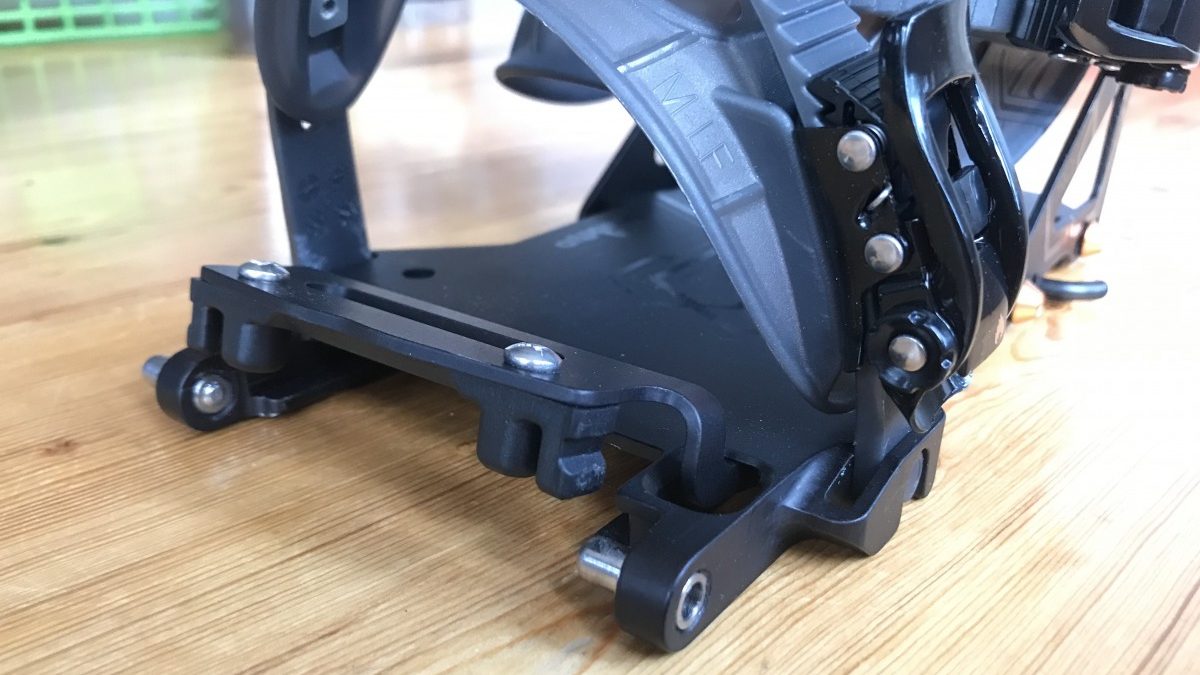
An intimate look at the T1 Tesla System and the locking componentry. Pins slide into the bracket R -> L and snap ramp secures the system, both in tour and ride mode.
– The bindings are simple and low profile, allowing a high level of intimacy with your snowboard.
– Flip and rip highbacks (Spark only, not Burton) allow for a quick toggling of forward lean. Literally flip the block to transition – no screws or fidgeting. The Flip and Rip system allows for 13 degrees of movement while touring, and an aggressive 22 degrees of forward lean should you want it.
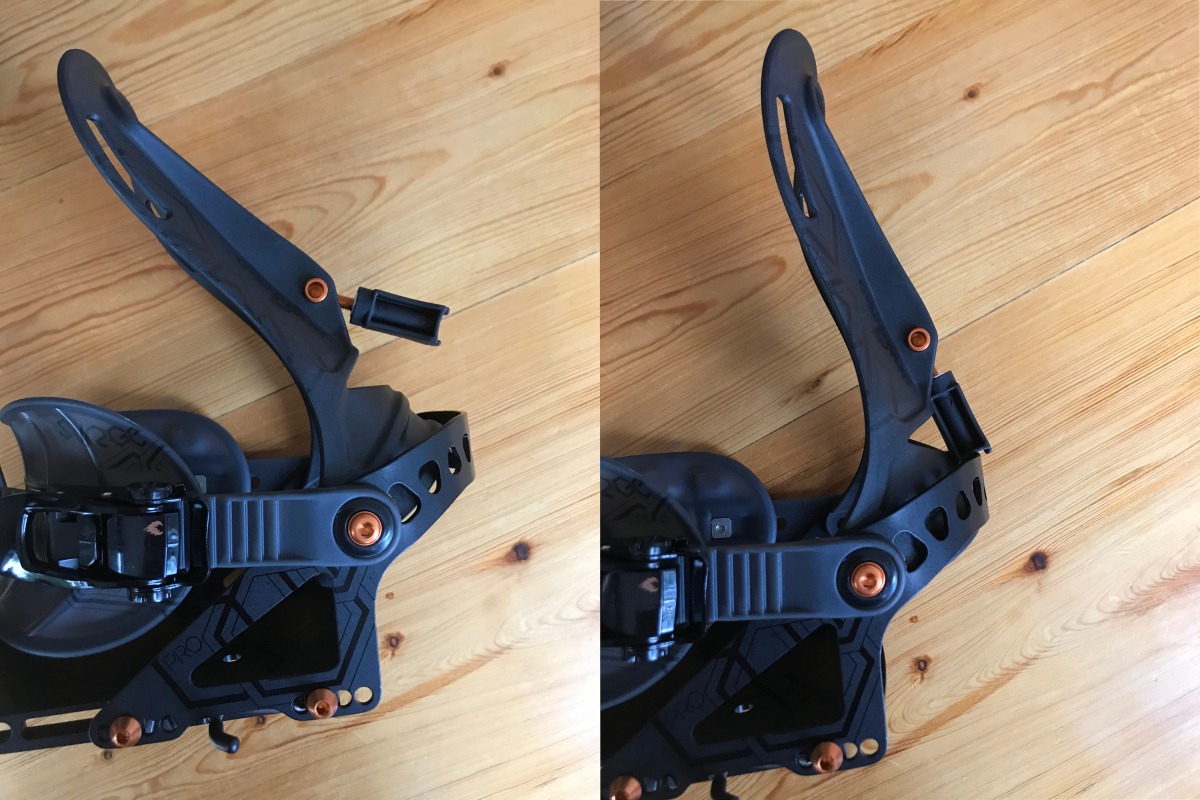
The Surge Pro’s Rip and Flip Highback. A demonstration of achievable range with and without forward lean.
Cons
– The pucks require an acquired aptitude to set up quickly and efficiently. The screw heads can penetrate and imbed in the plastic of the puck, resulting in a “memory” for a specific stance. This is solved with the new Spark Pucks that feature an aluminum head on a plastic puck base; these however are heavier than the traditional Voile pucks.
– The pan screws which hold the binding together are made from a different alloy than the bindings themselves. This difference in materials could allow for different rates of thermals expansion and loosening. *Despite not a single pan screw having come loose in two winters of use (even slightly), thermodynamic expansion allows me to maintain my skepticism…
– The traditional snowboard bootpack (one hand on each heel cup, plunge the snowboard’s toe edge in across the slope) doesn’t work due to the mechanism of the Tesla system. Slamming the toe edge of your board into a snowy slope will deactivate the Snap Ramp mechanism. When you pull up on your bindings to free the snowboard, you may just end up with bindings in your hands while your brand new no-board snakes your line! Unfortunately, you’ll need a pack for any committing “over-the-shoulder type” hiking
– Whammy Bars can be temperamental and difficult to manipulate. It’s sixes or half a dozen to determine if this is an advantageous system when compared to a traditional wire bracket heel riser.
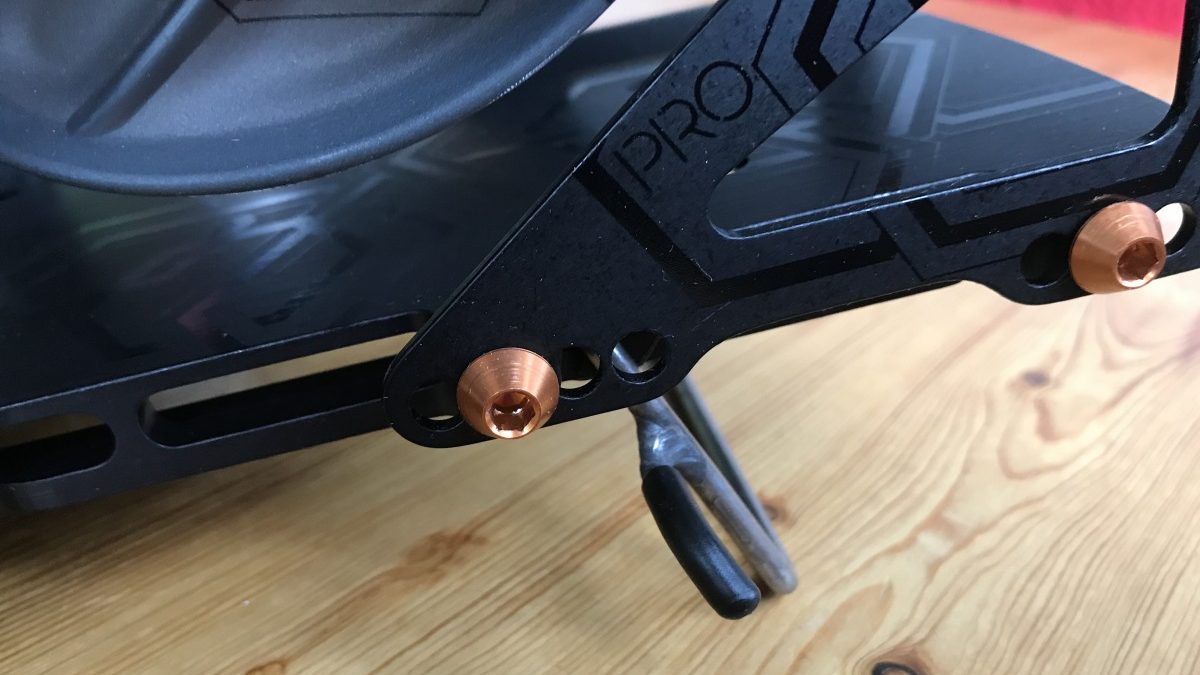
The Whammy Bar heel riser. The welded metal tab in the foreground is accessible and manipulatable with a pole, to keep you upright and your quad tension down. This mechanism has become less finicky with the newer generations of Spark Bindings. A good thing; adjustment should be easy.
– While touring in moist snowpacks, or wetter conditions,, the bindings provide an excellent ‘cookie cutter’ base which snow tends to pack into. These issues do not manifest with dryer snow.
– Anything can break given the incorrect circumstances, conditions, situation, etc. Although screwless and handy, should your toe straps wear through, you might loose a finger, or gain a puncture wound trying to cowboy or girl that little doggie loose. See more on that here.
*Although the Surge is light for a soft boot binding, the system is certainly heavier than its hard boot cousin. What one gains in efficiency, they lose in freedom of expression.
Closing thoughts
If we look honestly at how we as splitboarders move in the mountains, we choose to forgo a certain amount of efficiency for our passions. After thirteen years, some gained crust and crepitus, and revolution of splitboard equipment witnessed, I maintain a level of stubbornness. For a soft boot splitboarder seeking to hold the edges I have, the Spark Surge Pro offers a distinct advantage when compared to other soft boot bindings based on its simplicity, dependability, and adaptability. The Spark line offers a variety of options for different price points, all of which unite over the concepts of refinement and robustness. Whether you’re new to this, or staying true to this, Spark has something to ratchet your kit down one more click.
Nate Goodman currently lives in Whistler BC. He is a full time multidisciplinary guide, living a transitional life between North America, Japan and China. Nate is a disciple of core snowboarding, curious about the arcane nature of mountains, and is committed to the pursuit of enlightenment through the consumption of Sichuan-Chinese Food.
Nate Goodman currently lives in Whistler BC. He is a full time multidisciplinary guide, living a transitional life between North America, Japan and China. Nate is a disciple of core snowboarding, curious about the arcane nature of mountains, and is committed to the pursuit of enlightenment through the consumption of Sichuan-Chinese Food.

